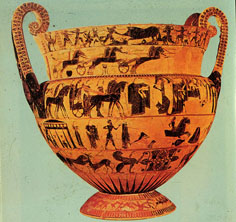
Knowledge of black figure technique is derived from:
The black portions of the vase are often called a black glaze but the term is misleading. The dark portions are produced by placing a clay slip (finer in texture than the clay of the pot and more liquidy). In black figure you have a clay slip placed against a red background (usually the color of the clay once fired). Details are incised. White and red paint were accessory colors; white for women and for hair and beards of old men, red for hair, manes of horses, parts of garments, etc. After the decoration was completed and the vases had become bone dry, they were placed in a kiln and fired [See C&H p.8 for an illustration of a kiln]. A single fire but in three successive stages:
Lastly, a red ochre application was applied to intensify the red of the clay. Black-figure vases we study in Year 13: |
|---|
